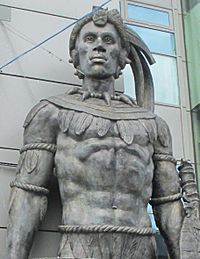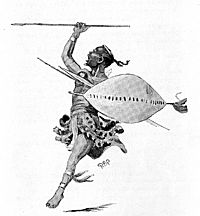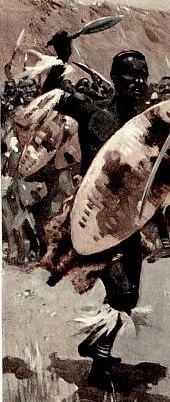Shaka facts for kids
Quick facts for kids King Shaka |
|||||||||
|---|---|---|---|---|---|---|---|---|---|
| ISilo Samabandla Onke | |||||||||
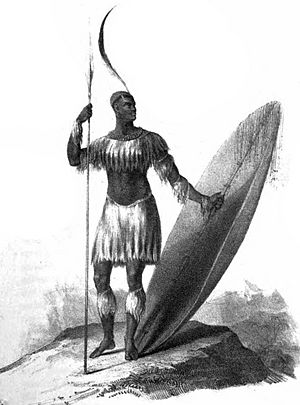
1824 European artist's impression of Shaka with a long throwing assegai and heavy shield. No drawings from life are known.
|
|||||||||
| King of the Zulus | |||||||||
| Reign | 1816–1828 | ||||||||
| Predecessor | Senzangakhona kaJama | ||||||||
| Successor | Dingane kaSenzangakhona | ||||||||
| Born | c. July 1787 Mthethwa Paramountcy (today near Melmoth, KwaZulu-Natal, South Africa) |
||||||||
| Died | 24 September 1828 (age 41) KwaDukuza, Kingdom of Zulu |
||||||||
| Burial | KwaDukuza | ||||||||
|
|||||||||
| House | House of Zulu | ||||||||
| Father | Senzangakhona kaJama | ||||||||
| Mother | Nandi | ||||||||
| Religion | Zulu religion | ||||||||
| Cause of death | Assassination (fratricide) | ||||||||
| Resting place | KwaDukuza, South Africa | ||||||||
Shaka kaSenzangakhona (c. 1787 – 22 September 1828), also known as Shaka Zulu, was a powerful king of the Zulu Kingdom in Southern Africa. He ruled from 1816 to 1828. Shaka is famous for making big changes that turned the Zulu military into a very strong fighting force. He is one of the most important Zulu monarchs in history.
Shaka was born in July 1787, near what is now Melmoth in KwaZulu-Natal, South Africa. He was the son of the Zulu King Senzangakhona kaJama. Because he was seen as an illegitimate son, Shaka spent his childhood with his mother. He later became a warrior in a fighting unit called an ibutho lempi under Inkosi Dingiswayo.
King Shaka improved the ibutho military system. With help from the Mthethwa Paramountcy, he made friends with smaller groups nearby. This helped them fight against raids from the Ndwandwe people in the north. Shaka often tried to solve problems peacefully, using diplomacy. But he also fought in many battles.
Shaka's rule happened at the start of the Mfecane (meaning "Upheaval" or "Crushing"). This was a time of big wars and chaos in southern Africa from about 1815 to 1840. Many people died or were forced to move during this period. Shaka's role in the Mfecane is still debated by historians. He was eventually killed by his half-brothers, King Dingane and Prince Mhlangana.
Contents
Shaka's Early Life and Rise to Power
When Shaka's father, Senzangakhona, died in 1816, Shaka's younger half-brother, Sigujana, became the Zulu chief. But Sigujana's rule was short. Dingiswayo helped Shaka by giving him a group of soldiers. Shaka then removed Sigujana from power in a mostly peaceful way, and the Zulu people accepted him.
So, Shaka became the Chief of the Zulu clan. He was still under the Mthethwa Paramountcy until Dingiswayo died in battle a year later. Dingiswayo was killed by Zwide, a powerful chief of the Ndwandwe nation. When the Mthethwa forces were scattered, Shaka stepped in. He brought together the remaining Mthethwa and other tribes. Later, he defeated Zwide in the Zulu Civil War around 1819–20.
When Zwide killed Dingiswayo, Shaka wanted revenge. Shaka eventually killed Zwide's mother, Ntombazi, who was a sangoma (traditional healer). Shaka then continued to hunt Zwide. They finally met in battle around 1825 near Phongola. Shaka won this battle, but his army lost many soldiers, including his main military leader, Umgobhozi Ovela Entabeni.
In his early years, Shaka did not have much power or fame. After Dingiswayo's death, Shaka moved south across the Thukela River. He built his capital, Bulawayo, in Qwabe territory. He never moved back to the original Zulu lands.
Expanding the Zulu Kingdom
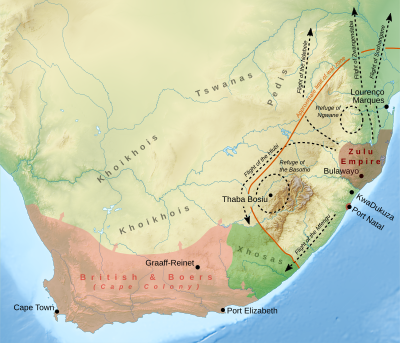
As Shaka gained more respect, he could share his ideas more easily. Because he was a soldier, Shaka taught the Zulus that the best way to become strong was to conquer and control other tribes. His ideas greatly changed the way Zulus thought about society. The Zulu tribe soon became known for its warriors, which Shaka used to his advantage.
Shaka's power came mostly from his strong military. He would defeat rival groups and add their remaining people to his army. He also used diplomacy and rewards to bring friendly chiefs into his kingdom. These chiefs, like Zihlandlo of the Mkhize, Jobe of the Sithole, and Mathubane of the Thuli, were never defeated by the Zulu. Shaka won them over with smart tactics.
Shaka still respected Dingiswayo and his larger Mthethwa Paramountcy clan. But after Dingiswayo was killed by Zwide, Shaka formed an alliance with the Mthethwa clan, who no longer had a leader. He also gained control of the Qwabe territory. With support from the Qwabe, Hlubi, and Mkhize, Shaka finally had an army strong enough to fight the Ndwandwe.
Historian Donald Morris says Shaka's first big battle against Zwide was the Battle of Gqokli Hill. Shaka's troops held a strong position on top of the hill. The enemy could not move them with a direct attack. Shaka won by sending his reserve forces around the hill to attack the enemy from behind. Both sides had many losses, but Shaka's new fighting methods proved to be very effective.
Another important battle happened at the Mhlatuze River. In a two-day battle, the Zulu army strongly defeated their enemies. Shaka then led his fresh reserve forces about 70 miles (110 km) to Zwide's royal home and destroyed it. Zwide himself escaped but died in mysterious ways soon after.
Shaka sometimes allowed Europeans into Zulu land. In the mid-1820s, Henry Francis Fynn treated Shaka after an assassination attempt. To show his thanks, Shaka let European settlers enter and work in the Zulu kingdom. Shaka saw European technology, but he believed the Zulu way was better.
The Death of King Shaka
Dingane and Mhlangana, Shaka's half-brothers, tried to kill Shaka at least twice before they succeeded. They may have had help from other groups who were unhappy with Shaka. Shaka had made many enemies among his own people, which led to his downfall.
His death happened soon after his mother, Nandi, died in October 1827. Shaka became very upset and acted strangely after her death. According to Donald Morris, Shaka ordered that no crops should be planted for a year. No milk, which was a main part of the Zulu diet, could be used. Any pregnant woman and her husband were to be killed. At least 7,000 people were killed because they were not sad enough. Even cows were killed so their calves would know what losing a mother felt like.
Shaka was killed by three assassins in 1828, most likely in September. At that time, most of the Zulu army was away on a mission to the north. This left the royal home without much protection. The conspirators were Shaka's half-brothers, Dingane and Mhlangana, and a chief called Mbopa. Mbopa created a distraction, and Dingane and Mhlangana delivered the fatal blows. Shaka's body was thrown into an empty grain pit and covered with stones and mud. The exact spot is not known.
Shaka's half-brother Dingane took power. He spent several years getting rid of people and chiefs who supported Shaka to make sure his position was safe. Dingane allowed soldiers to marry and build homes, which Shaka had forbidden. He also gave them cattle. Dingane ruled for about twelve years. He fought against the Voortrekkers (European settlers) and against another half-brother, Mpande, who took over in 1840 with European help.
Shaka's Military Changes
Some older history books questioned if Shaka really invented the military and social changes he is known for. They sometimes said Europeans influenced him. But newer research shows that the Zulu culture already had many practices that Shaka could use to achieve his goals, whether for raiding or conquering.
New Weapons and Shields
Shaka is often said to have changed the long throwing spear, called an assegai. He is credited with introducing a new weapon: the iklwa. This was a short stabbing spear with a long, wide, sword-like blade.
While Shaka probably did not invent the iklwa, he made sure his warriors trained with it. This gave them a big advantage over enemies who just threw their spears and avoided close fighting. The throwing spear was still used first, but the shorter stabbing spear was used for hand-to-hand combat.
It is also believed that Shaka introduced a larger, heavier version of the Nguni shield. He is also thought to have taught his warriors to use the left side of their shield to hook the enemy's shield to the right. This would expose the enemy's ribs for a deadly spear stab. During Shaka's time, the king provided these cowhide shields. Different colored shields showed different groups of soldiers within Shaka's army.
Army Movement and Training
There is a story that Shaka made his warriors go without sandals to toughen their feet. Those who refused were killed. Shaka made his troops train often, with long marches that sometimes covered more than 50 miles (80 km) a day at a fast trot over rough land. He also trained them to use encirclement tactics, where they would surround the enemy.
Some historians disagree with these stories, saying that the Zulu army usually covered less distance per day. However, many other historians who study the Zulu military system still believe in the high mobility of Shaka's army.
Support from Young People
Boys aged six and older joined Shaka's army as udibi, or apprentice warriors. They carried food, supplies like cooking pots and sleeping mats, and extra weapons. They did this until they were old enough to join the main fighting ranks. These young helpers allowed the main army to move quickly without being weighed down by heavy supplies.
Age-Grade System for Regiments
Grouping people by age was common in Bantu cultures. These age groups did many things, from guarding camps to herding cattle. Shaka organized these groups into regiments. He housed them in special military camps, and each regiment had its own name and symbols. This system helped Shaka build a strong, organized army for his expansion plans.
"Bull Horn" Battle Formation
Many historians say Shaka developed the famous "bull horn" battle formation. It had three parts:
- The chest was the main force. It would meet the enemy head-on and hold them in place, fighting hand-to-hand. These warriors were experienced veterans.
- The horns were young, fast warriors. While the "chest" held the enemy, the "horns" would move around both sides of the enemy and surround them. Then, with the "chest," they would destroy the trapped enemy.
- The loins were a large reserve force. They were hidden behind the "chest," sitting with their backs to the battle so they would not lose confidence. The "loins" would be sent in wherever the enemy tried to break out of the encirclement.
Strict Discipline
Shaka made his army very determined. He taught his warriors what would happen if they were not brave in battle or if their regiments were defeated. A harsh fate awaited them and their families if they did not fight well.
Zulu Methods vs. European Technology
The growing Zulu power eventually met European power after Shaka's death. European travelers showed Shaka advanced technology like firearms and writing. But Shaka was not impressed. He said there was no need to write messages because his messengers would be killed if they brought wrong news. For firearms, Shaka saw they were useful for shooting from a distance. But he argued that by the time a gunman reloaded, Zulu warriors with spears would already be on top of them.
The first big clash after Shaka's death was under his successor, Dingane. They fought against European Voortrekkers from the Cape. The Zulu first won with fast, surprise attacks. But the Voortrekkers later defeated the Zulu from their fortified wagon camp at the Battle of Blood River. The second big clash was against the British in 1879. Again, Zulu successes came from their speed and ability to surround enemies. Their major victory at the Battle of Isandlwana was the most famous.
Shaka's Legacy and Impact
Many historians say Shaka "changed how wars were fought in Southern Africa." He turned warfare from simple challenges into a way to conquer and control others. Other writers focus on his military changes, like the iklwa spear and the "buffalo horns" formation. This combination has been compared to the organized Roman legions.
By the time Shaka was killed in 1828, his methods had made the Zulu kingdom the greatest power in southern Africa. It was a force that even the British army had to respect in 1879.
However, there is still much debate about Shaka's character and actions. Some scholars believe that the idea of Shaka as a genius who created everything new is exaggerated. They argue that he actually borrowed and copied existing local methods and customs.
The Mfecane Period
The increased military power of Shaka's army led to more and more clans joining his Zulu empire. Other tribes moved away to escape his armies. The effect of these mass movements became known as the Mfecane (annihilation).
Shaka's army began a huge expansion. They killed or enslaved those who resisted in the lands they conquered. His impis (warrior regiments) were very disciplined: if they failed in battle, they faced death.
When he died, Shaka ruled over 250,000 people and could gather more than 50,000 warriors. His 10-year rule led to a huge number of deaths, mostly because of the chaos the Zulu caused among neighboring tribes. The exact number of deaths is still debated. Many more people died during mass migrations as tribes tried to escape his armies.
The Mfecane also led to the rise of other important leaders. Mzilikazi, one of Shaka's generals, fled and later built his own empire in Zimbabwe. Soshangane expanded from the Zulu area into what is now Mozambique.
Some scholars say that the idea of Shaka being a monster responsible for all the devastation was used by historians during the apartheid era to justify racist policies. However, others argue that while there might have been some distortion, stories of violence and destruction were based on real accounts from many victims and refugees. For example, the village of Lepalong was built underground to protect the Kwena people from the chaos during Shaka's time.
In Zulu Culture
Shaka is still a very interesting figure for the Zulu people and for many around the world. Today, people often see him as a hero. Popular movies and other media have helped this view. Traditional Zulu culture still honors the dead king, as shown in their praise songs.
However, some Zulu stories are critical of Shaka. There are many negative images of him in Zulu oral history. For example, when Shaka's mother Nandi died, the king ordered a huge display of grief, including mass executions. He also forbade planting crops or using milk, and ordered the killing of all pregnant women and their husbands. Oral stories say that during this time, a Zulu man named Gala bravely stood up to Shaka. He pointed out that Nandi was not the first person to die in Zululand. Shaka was surprised by this honest talk and supposedly called off his harsh orders, even rewarding Gala with cattle.
So, Shaka remains a complex figure in African oral tradition. He is not simply a heroic nation-builder or a terrible monster. This complexity keeps his image powerful and influential, even almost two centuries after his death.
Legacy
- uShaka Marine World, a water theme park in Durban, opened in 2004.
- The King Shaka International Airport near Durban opened on May 1, 2010, before the 2010 FIFA World Cup.
See also
 In Spanish: Shaka para niños
In Spanish: Shaka para niños
- List of Zulu kings
- Hintsa kaKhawuta
- Amathole Mountains
- Matiwane
- African military systems to 1800
- African military systems (1800–1900)
- African military systems after 1900
- Legends of Africa
- Moshoeshoe I
- Ndebele
- List of South Africans
- Chaka
- Emperor Shaka the Great
- Lion's Blood
- Sekhukhune I


